Keke Tang
LoRA-PAR: A Flexible Dual-System LoRA Partitioning Approach to Efficient LLM Fine-Tuning
Jul 28, 2025Abstract:Large-scale generative models like DeepSeek-R1 and OpenAI-O1 benefit substantially from chain-of-thought (CoT) reasoning, yet pushing their performance typically requires vast data, large model sizes, and full-parameter fine-tuning. While parameter-efficient fine-tuning (PEFT) helps reduce cost, most existing approaches primarily address domain adaptation or layer-wise allocation rather than explicitly tailoring data and parameters to different response demands. Inspired by "Thinking, Fast and Slow," which characterizes two distinct modes of thought-System 1 (fast, intuitive, often automatic) and System 2 (slower, more deliberative and analytic)-we draw an analogy that different "subregions" of an LLM's parameters might similarly specialize for tasks that demand quick, intuitive responses versus those requiring multi-step logical reasoning. Therefore, we propose LoRA-PAR, a dual-system LoRA framework that partitions both data and parameters by System 1 or System 2 demands, using fewer yet more focused parameters for each task. Specifically, we classify task data via multi-model role-playing and voting, and partition parameters based on importance scoring, then adopt a two-stage fine-tuning strategy of training System 1 tasks with supervised fine-tuning (SFT) to enhance knowledge and intuition and refine System 2 tasks with reinforcement learning (RL) to reinforce deeper logical deliberation next. Extensive experiments show that the two-stage fine-tuning strategy, SFT and RL, lowers active parameter usage while matching or surpassing SOTA PEFT baselines.
SEER: Semantic Enhancement and Emotional Reasoning Network for Multimodal Fake News Detection
Jul 17, 2025Abstract:Previous studies on multimodal fake news detection mainly focus on the alignment and integration of cross-modal features, as well as the application of text-image consistency. However, they overlook the semantic enhancement effects of large multimodal models and pay little attention to the emotional features of news. In addition, people find that fake news is more inclined to contain negative emotions than real ones. Therefore, we propose a novel Semantic Enhancement and Emotional Reasoning (SEER) Network for multimodal fake news detection. We generate summarized captions for image semantic understanding and utilize the products of large multimodal models for semantic enhancement. Inspired by the perceived relationship between news authenticity and emotional tendencies, we propose an expert emotional reasoning module that simulates real-life scenarios to optimize emotional features and infer the authenticity of news. Extensive experiments on two real-world datasets demonstrate the superiority of our SEER over state-of-the-art baselines.
Exploring Visual Prompting: Robustness Inheritance and Beyond
Jun 07, 2025Abstract:Visual Prompting (VP), an efficient method for transfer learning, has shown its potential in vision tasks. However, previous works focus exclusively on VP from standard source models, it is still unknown how it performs under the scenario of a robust source model: Can the robustness of the source model be successfully inherited? Does VP also encounter the same trade-off between robustness and generalization ability as the source model during this process? If such a trade-off exists, is there a strategy specifically tailored to VP to mitigate this limitation? In this paper, we thoroughly explore these three questions for the first time and provide affirmative answers to them. To mitigate the trade-off faced by VP, we propose a strategy called Prompt Boundary Loosening (PBL). As a lightweight, plug-and-play strategy naturally compatible with VP, PBL effectively ensures the successful inheritance of robustness when the source model is a robust model, while significantly enhancing VP's generalization ability across various downstream datasets. Extensive experiments across various datasets show that our findings are universal and demonstrate the significant benefits of the proposed strategy.
HyperDet: Source Detection in Hypergraphs via Interactive Relationship Construction and Feature-rich Attention Fusion
May 19, 2025Abstract:Hypergraphs offer superior modeling capabilities for social networks, particularly in capturing group phenomena that extend beyond pairwise interactions in rumor propagation. Existing approaches in rumor source detection predominantly focus on dyadic interactions, which inadequately address the complexity of more intricate relational structures. In this study, we present a novel approach for Source Detection in Hypergraphs (HyperDet) via Interactive Relationship Construction and Feature-rich Attention Fusion. Specifically, our methodology employs an Interactive Relationship Construction module to accurately model both the static topology and dynamic interactions among users, followed by the Feature-rich Attention Fusion module, which autonomously learns node features and discriminates between nodes using a self-attention mechanism, thereby effectively learning node representations under the framework of accurately modeled higher-order relationships. Extensive experimental validation confirms the efficacy of our HyperDet approach, showcasing its superiority relative to current state-of-the-art methods.
SourceDetMamba: A Graph-aware State Space Model for Source Detection in Sequential Hypergraphs
May 19, 2025Abstract:Source detection on graphs has demonstrated high efficacy in identifying rumor origins. Despite advances in machine learning-based methods, many fail to capture intrinsic dynamics of rumor propagation. In this work, we present SourceDetMamba: A Graph-aware State Space Model for Source Detection in Sequential Hypergraphs, which harnesses the recent success of the state space model Mamba, known for its superior global modeling capabilities and computational efficiency, to address this challenge. Specifically, we first employ hypergraphs to model high-order interactions within social networks. Subsequently, temporal network snapshots generated during the propagation process are sequentially fed in reverse order into Mamba to infer underlying propagation dynamics. Finally, to empower the sequential model to effectively capture propagation patterns while integrating structural information, we propose a novel graph-aware state update mechanism, wherein the state of each node is propagated and refined by both temporal dependencies and topological context. Extensive evaluations on eight datasets demonstrate that SourceDetMamba consistently outperforms state-of-the-art approaches.
EOOD: Entropy-based Out-of-distribution Detection
Apr 04, 2025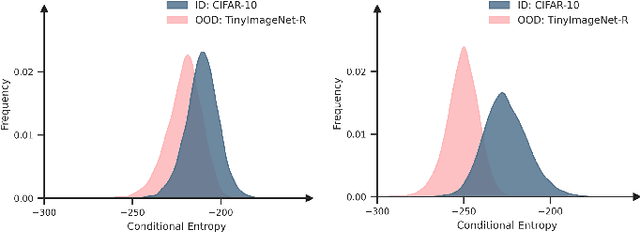

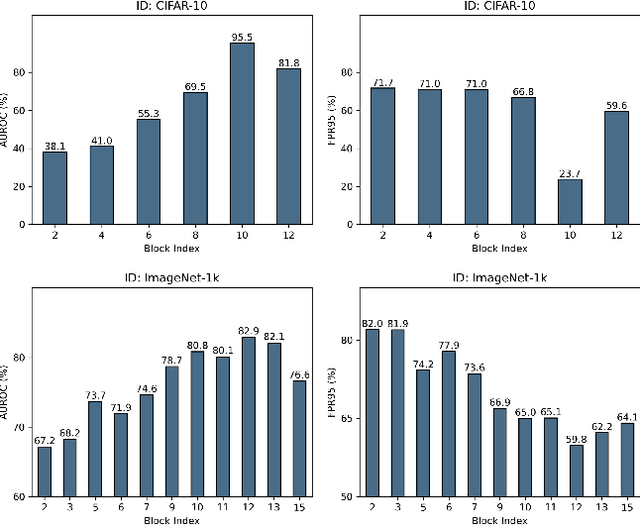
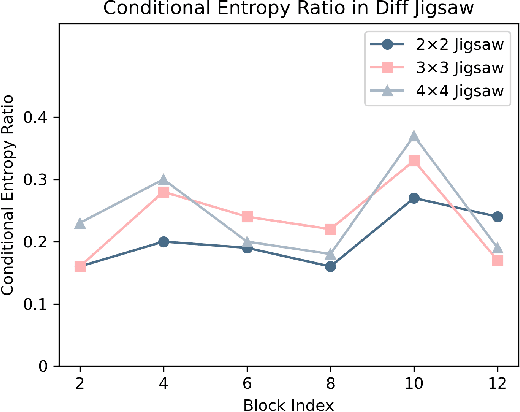
Abstract:Deep neural networks (DNNs) often exhibit overconfidence when encountering out-of-distribution (OOD) samples, posing significant challenges for deployment. Since DNNs are trained on in-distribution (ID) datasets, the information flow of ID samples through DNNs inevitably differs from that of OOD samples. In this paper, we propose an Entropy-based Out-Of-distribution Detection (EOOD) framework. EOOD first identifies specific block where the information flow differences between ID and OOD samples are more pronounced, using both ID and pseudo-OOD samples. It then calculates the conditional entropy on the selected block as the OOD confidence score. Comprehensive experiments conducted across various ID and OOD settings demonstrate the effectiveness of EOOD in OOD detection and its superiority over state-of-the-art methods.
Imperceptible Adversarial Attacks on Point Clouds Guided by Point-to-Surface Field
Dec 26, 2024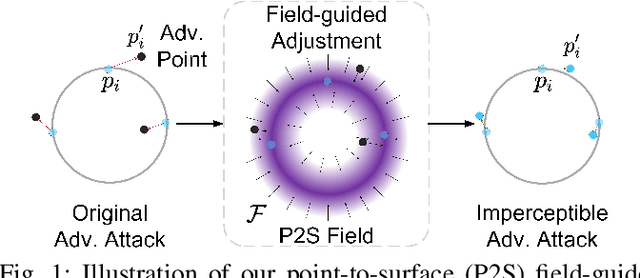
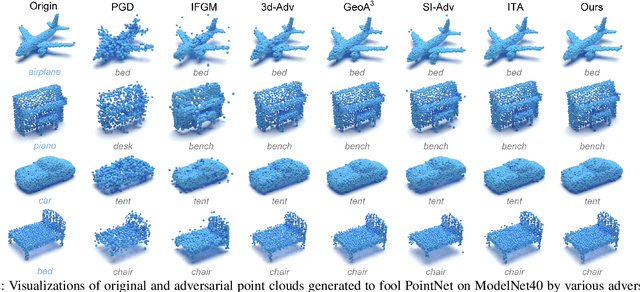

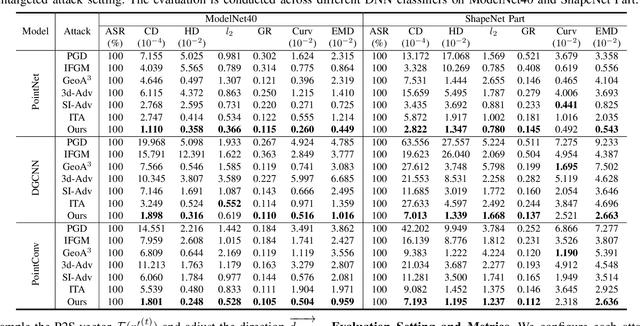
Abstract:Adversarial attacks on point clouds are crucial for assessing and improving the adversarial robustness of 3D deep learning models. Traditional solutions strictly limit point displacement during attacks, making it challenging to balance imperceptibility with adversarial effectiveness. In this paper, we attribute the inadequate imperceptibility of adversarial attacks on point clouds to deviations from the underlying surface. To address this, we introduce a novel point-to-surface (P2S) field that adjusts adversarial perturbation directions by dragging points back to their original underlying surface. Specifically, we use a denoising network to learn the gradient field of the logarithmic density function encoding the shape's surface, and apply a distance-aware adjustment to perturbation directions during attacks, thereby enhancing imperceptibility. Extensive experiments show that adversarial attacks guided by our P2S field are more imperceptible, outperforming state-of-the-art methods.
Hypergraph Attacks via Injecting Homogeneous Nodes into Elite Hyperedges
Dec 24, 2024Abstract:Recent studies have shown that Hypergraph Neural Networks (HGNNs) are vulnerable to adversarial attacks. Existing approaches focus on hypergraph modification attacks guided by gradients, overlooking node spanning in the hypergraph and the group identity of hyperedges, thereby resulting in limited attack performance and detectable attacks. In this manuscript, we present a novel framework, i.e., Hypergraph Attacks via Injecting Homogeneous Nodes into Elite Hyperedges (IE-Attack), to tackle these challenges. Initially, utilizing the node spanning in the hypergraph, we propose the elite hyperedges sampler to identify hyperedges to be injected. Subsequently, a node generator utilizing Kernel Density Estimation (KDE) is proposed to generate the homogeneous node with the group identity of hyperedges. Finally, by injecting the homogeneous node into elite hyperedges, IE-Attack improves the attack performance and enhances the imperceptibility of attacks. Extensive experiments are conducted on five authentic datasets to validate the effectiveness of IE-Attack and the corresponding superiority to state-of-the-art methods.
Multi-Pair Temporal Sentence Grounding via Multi-Thread Knowledge Transfer Network
Dec 20, 2024



Abstract:Given some video-query pairs with untrimmed videos and sentence queries, temporal sentence grounding (TSG) aims to locate query-relevant segments in these videos. Although previous respectable TSG methods have achieved remarkable success, they train each video-query pair separately and ignore the relationship between different pairs. We observe that the similar video/query content not only helps the TSG model better understand and generalize the cross-modal representation but also assists the model in locating some complex video-query pairs. Previous methods follow a single-thread framework that cannot co-train different pairs and usually spends much time re-obtaining redundant knowledge, limiting their real-world applications. To this end, in this paper, we pose a brand-new setting: Multi-Pair TSG, which aims to co-train these pairs. In particular, we propose a novel video-query co-training approach, Multi-Thread Knowledge Transfer Network, to locate a variety of video-query pairs effectively and efficiently. Firstly, we mine the spatial and temporal semantics across different queries to cooperate with each other. To learn intra- and inter-modal representations simultaneously, we design a cross-modal contrast module to explore the semantic consistency by a self-supervised strategy. To fully align visual and textual representations between different pairs, we design a prototype alignment strategy to 1) match object prototypes and phrase prototypes for spatial alignment, and 2) align activity prototypes and sentence prototypes for temporal alignment. Finally, we develop an adaptive negative selection module to adaptively generate a threshold for cross-modal matching. Extensive experiments show the effectiveness and efficiency of our proposed method.
A General Black-box Adversarial Attack on Graph-based Fake News Detectors
Apr 26, 2024Abstract:Graph Neural Network (GNN)-based fake news detectors apply various methods to construct graphs, aiming to learn distinctive news embeddings for classification. Since the construction details are unknown for attackers in a black-box scenario, it is unrealistic to conduct the classical adversarial attacks that require a specific adjacency matrix. In this paper, we propose the first general black-box adversarial attack framework, i.e., General Attack via Fake Social Interaction (GAFSI), against detectors based on different graph structures. Specifically, as sharing is an important social interaction for GNN-based fake news detectors to construct the graph, we simulate sharing behaviors to fool the detectors. Firstly, we propose a fraudster selection module to select engaged users leveraging local and global information. In addition, a post injection module guides the selected users to create shared relations by sending posts. The sharing records will be added to the social context, leading to a general attack against different detectors. Experimental results on empirical datasets demonstrate the effectiveness of GAFSI.
 Add to Chrome
Add to Chrome Add to Firefox
Add to Firefox Add to Edge
Add to Edge